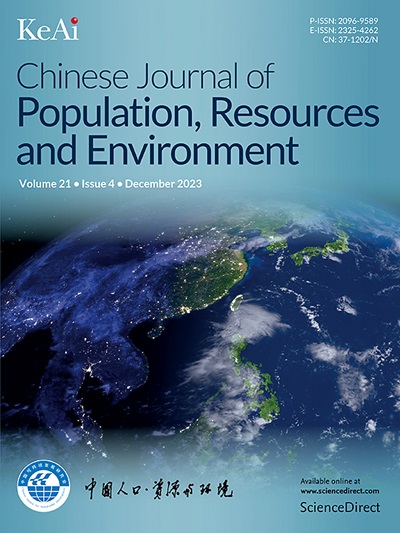中国经济空间格局及其影响因素的空间异质性——基于夜间照明数据的实证研究
IF 4.8
4区 环境科学与生态学
Q2 ENVIRONMENTAL STUDIES
Chinese Journal of Population Resources and Environment
Pub Date : 2025-06-01
DOI:10.1016/j.cjpre.2025.05.007
引用次数: 0
摘要
改革开放以来,中国经济快速发展。然而,由于地理位置和政策的原因,各地的发展速度不同,导致了显著的经济差异。基于2013 - 2021年中国281个城市空间单元的夜间照明数据,采用空间自相关、重心偏移和标准差椭圆(SDE)分析方法对中国城市经济的空间格局演变进行了研究。在此基础上,运用地理加权回归(GWR)模型探讨中国城市经济差异及其空间异质性的影响因素。本文揭示了以下结果。第一,中国城市经济整体呈现增长态势。②SDE呈“南北”分布格局,中国经济发展集中度略有上升,向心分布明显。③空间相关性呈现空间正相关,且正相关程度不断增强,具有较强的空间异质性和区域集聚性。最后,根据GWR衡量影响因素,由于产业结构的转型程度和教育支出对经济增长的滞后效应,产业结构和教育支出系数总体上呈现由东南沿海向西北和内陆递减的趋势。相反,由于创新驱动力的边际效用递减规律和城市化发展的差异,创新驱动力系数和城市面积系数呈现由西北内陆向东南沿海递减的趋势。受政策偏向和市场发展水平等因素的影响,政府支出系数东部呈较高趋势,西部呈较低趋势。本研究可为中国实现高质量发展、走向共同富裕提供理论参考。本文章由计算机程序翻译,如有差异,请以英文原文为准。
Spatial pattern of the Chinese economy and spatial heterogeneity of its influential factors: An empirical study based on nighttime lighting data
China’s economy has developed rapidly since its reform and opening-up. However, the different rates of development in various places due to location and policies have led to significant economic differences. Based on the nighttime lighting data of 281 municipal spatial units in China from 2013 to 2021, this study uses spatial autocorrelation, center of gravity shift, and standard deviation ellipse (SDE) analysis to examine the evolution of the spatial pattern of China’s municipal economy. Based on these, it uses a geographically weighted regression (GWR) model to explore the factors influencing the differences in China’s municipal economy and its spatial heterogeneity. The paper reveals the following results. First, China’s municipal economy as a whole shows a growing trend. Second, the SDE shows a “north-south” distribution pattern, and the concentration of China’s economic development has slightly increased, with a significant centripetal distribution. Third, spatial correlation shows spatial positive correlation, the degree of which is increasing, with strong spatial heterogeneity and regional agglomeration. Finally, measuring the influencing factors according to GWR, the industrial structure and education expenditure coefficients generally show a decreasing trend from the southeast coast to the northwest and inland due to the degree of transformation of industrial structure and the lagging effect of education expenditure on economic growth. Conversely, the innovation driver and urban area coefficients show a decreasing trend from the northwest inland to the southeast coast due to the law of diminishing marginal utility of innovation drivers and differences in urbanization development. Government expenditure coefficients show a higher trend in the East and a lower trend in the West due to policy favoritism and market development level. This research can serve as a theoretical reference for China to achieve high-quality development and move toward common prosperity.
求助全文
通过发布文献求助,成功后即可免费获取论文全文。
去求助
来源期刊

Chinese Journal of Population Resources and Environment
ENVIRONMENTAL STUDIES-
CiteScore
4.30
自引率
1.10%
发文量
791
审稿时长
79 days
期刊介绍:
The Chinese Journal of Population, Resources and Environment (CJPRE) is a peer-reviewed international academic journal that publishes original research in the fields of economic, population, resource, and environment studies as they relate to sustainable development. The journal aims to address and evaluate theoretical frameworks, capability building initiatives, strategic goals, ethical values, empirical research, methodologies, and techniques in the field. CJPRE began publication in 1992 and is sponsored by the Chinese Society for Sustainable Development (CSSD), the Research Center for Sustainable Development of Shandong Province, the Administrative Center for China's Agenda 21 (ACCA21), and Shandong Normal University. The Chinese title of the journal was inscribed by the former Chinese leader, Mr. Deng Xiaoping. Initially focused on China's advances in sustainable development, CJPRE now also highlights global developments from both developed and developing countries.
 求助内容:
求助内容: 应助结果提醒方式:
应助结果提醒方式:


